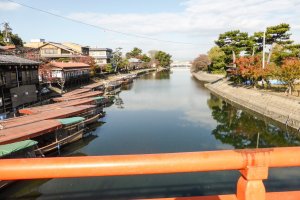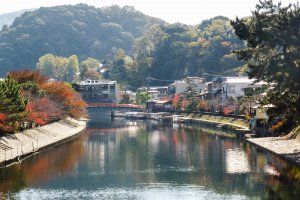One of my highlights from a recent visit to Japan was an overnight stay in Uji, a small city on the southern outskirts of Kyoto.
Slightly off the beaten-track, Uji is well worth adding to your bucket list if you’ve already made it to nearby Kyoto or Osaka. It offers a chance to take in a more traditional Japan with plenty of natural beauty, history and artisan culture, at a more relaxed pace compared to the crowded tourist hotspots of Kyoto.
Highlights of Uji
A stroll down Uji-gawa river provides one of the most picturesque images of Japan’s natural beauty. Traditional wooden houses and rows of little riverboats that line the riverbanks; the orange of the Kisen-bashi footbridge that perfectly punctures the backdrop of the lush green rolling hills; and the impressive 14-metre tall stone pagoda (said to have been built as a prayer to keep animals from being killed) on Tonoshima Island, east of the bridge, all provide images of quintessential Japan that you will never forget.
A little further up the river is Byodo-in Temple. Visiting Byodo-in Temple should be first on your must-see list if you make it to Uji. As a UNESCO World Heritage-protected site, this Buddhist temple is one of the most famous attractions of Uji, so much so that you will find it featured on the reverse side of the 10 yen coin. Built in 1053, the temple is famous for its Phoenix Hall, so-named because of the two statues representing two phoenixes on the roof. The vibrant red colour of the Phoenix Hall and the way it is reflected in the green-grey water of the surrounding lotus pond creates an ethereal beauty and there’s a real feeling of serenity as you walk through the grounds and various buildings. To enter the temple you must buy a 600-yen ticket which grants you access to the grounds and museum. To view inside the Phoenix Hall you need an additional 300-yen ticket from another ticket desk inside the grounds. But be warned there are often long queues to enter the Hall so I didn’t manage to get in although I hear it’s definitely worth it if you have time. Grounds are open 08:30-1730.
Uji is famous for growing the finest green tea; it is in fact considered to be the tea-capital of Japan! The tea history of this city dates back to the thirteenth century, when it is said a Zen monk named Eisai gave seeds from China to a local priest in order to open a tea farm. Uji's sloping hills, rich soil, and the wide range of temperature between day and night time are thought to make the perfect conditions for producing the highest-quality green tea. This tea, or “matcha” as it’s called in Japanese, has gained superfood status across Western countries in recent years due to its high level of antioxidants and it can be found flavouring a huge array of products in Japan. So I highly recommend a walk down Byodo-in Omotesando Street to try out and pick up your own “matcha” products for bringing back home. The street is packed with little quaint shops selling tea and tea-related products ranging from actual matcha powder, tea-flavoured noodles, ice-creams, and endless types of sweets. Inside some of the stores you can even see steamed tea leaves being ground to matcha powder.
































